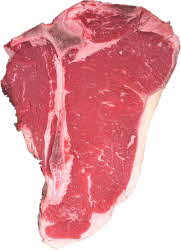See also: Ground Beef; Cattle; Dairy Cattle; Cows; Ranches; etc.
BEEF TRIVIA

The world is projected to produce 58.625 million metric tons of beef in 2014. If realized, this will be the most beef that the world has ever produced
Brazil is the world's largest producer of beef. (2010)
Hernando Cortez brought the first cattle to North America in 1519 (Columbus brought cattle with him on his 2nd voyage to the New World, but not to North America).
There are 9 people in the U.S. listed on whitepages.com with the last name 'Beef'
(Mark Morton, 'Gastronomica', Fall 2010)
The character of 'Uncle Sam' is modeled after Sam Wilson, a meatpacker from Troy, New York. During the War of 1812, the meat he shipped to the government was stamped 'U.S. Beef.' Soldiers began to call this beef Uncle Sam’s beef.
More beef is consumed on Memorial Day than any other day, with the 4th of July and Labor Day usually tieing for 2nd place.

Top 10 list of beef entrees (excluding burgers) in the U.S.
1) Prime Rib
2) Strip Steak
3) Filet Mignon/Tenderloin
4) Roast Beef
5) Rib/Ribeye Steak
6) Meatloaf
7) Sirloin/Top Butt Steak
8) Chicken Fried Steak
9) Meatballs
10) T-Bone/Porterhouse Steak
Total U.S. beef consumption:
• 2011: 25.6 billion pounds
• 2010: 26.4 billion pounds
• 2009: 26.8 billion pounds
• 2008: 27.3 billion pounds
• 2007: 28.1 billion pounds
• 2006: 28.1 billion pounds
• 2005: 27.8 billion pounds
• 2004: 27.8 billion pounds
• 2003: 27.0 billion pounds
• 2002: 27.9 billion pounds
(USDA Economic Research Service)
In 2007, 97% of commercial restaurants served beef in one form or another.
National Cattlemen's Beef Association
Over 400 million steak sandwiches were served in 2001 - an increase of 25% over 2000.
Argentinians eat more beef than anyone else, about 140 pounds a year per person. (The U.S. average is about half that).
BEEF QUALITY GRADING
U.S.D.A. Beef Quality grades are determined by estimating the age of the animal, the amount of fat marbling (determined by looking at the ribeye at the 12th rib) and by the texture, color and appearance of the ribeye. U.S.D.A. quality grading is optional.
According to the National Cattleman's Beef Association only about 2% of all U.S. beef carcases submitted for grading are quality graded Prime. Prime grade is the most tender, juicy and flavorful grade, and most Prime grade beef is sold to the restaurant industry.
About 44% of the beef submitted for quality grading is Choice grade (the next grade down from Prime), and this is what is usually available in retail markets.
FREE Magazines
and other Publications
An extensive selection of free magazines and other publications
Also see: Food Articles and Cooking Tips
FOOD TRIVIA and FOOD FACTS
Please feel free to link to any pages of FoodReference.com from your website.
For permission to use any of this content please E-mail: james@foodreference.com
All contents are copyright © 1990 - 2024 James T. Ehler and www.FoodReference.com unless otherwise noted.
All rights reserved. You may copy and use portions of this website for non-commercial, personal use only.
Any other use of these materials without prior written authorization is not very nice and violates the copyright.
Please take the time to request permission.
Popular Pages
CULINARY SCHOOLS
& COOKING CLASSES
From Amateur & Basic Cooking Classes to Professional Chef Training & Degrees
FoodReference.com (since 1999)
Home | Articles | FOOD TRIVIA | Today in Food History | Food_Timeline | Recipes | Cooking_Tips | Food Quotes | Who’s Who | Culinary Schools and Tours | Food_Trivia_Quizzes | Food Poems | Free Magazines | Food Festivals & Events
You are here > Home >
FOOD TRIVIA and FOOD FACTS SECTION
